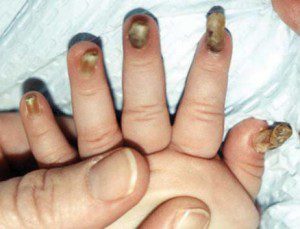
Congenital pachyonychia
Contents:
Overview of Pachyonychia Congenita
Pachyonychia congenita (PC) is a very rare genetic disease that affects the skin and nails. Symptoms usually appear at birth or early in life, and the disease affects people of both sexes and all racial and ethnic groups.
PC is caused by mutations affecting keratins, proteins that provide structural support to cells, and is classified into five types depending on which keratin gene contains the mutation. Symptoms vary from person to person and depend on the type, but thickening of the nails and calluses on the soles of the feet occur in almost all cases. The most debilitating symptom is painful calluses on the soles that make walking difficult. Some patients rely on a cane, crutches, or a wheelchair to manage pain when walking.
There is no specific treatment for PC, but there are ways to manage the symptoms, including pain.
Who gets congenital pachyonychia?
People with congenital pachyonychia have a mutation in one of five keratin genes. Researchers have found more than 115 mutations in these genes associated with the disease. In some cases, PCa is inherited from parents, while in others there is no family history and the cause is a spontaneous mutation. The disorder is genetically dominant, meaning that one copy of the mutated gene is enough to cause the disease. PC is very rare. The disease affects people of both sexes and all racial and ethnic groups.
Types of congenital pachyonychia
There are five types of pachyonychia congenita and they are classified based on the altered keratin gene. Thickened nails and painful calluses on the soles of the feet are common in all forms of the disease, but the presence of other features may depend on which keratin gene is affected and possibly on the particular mutation.
Symptoms of congenital pachyonychia
The symptoms and severity of PCa can vary greatly, even among people with the same type or in the same family. Most symptoms usually appear during the first months or years of life.
The most common PC features include:
- Painful calluses and blisters on the soles of the feet. In some cases, the calluses itch. Calluses and blisters can also form on the palms.
- Thickened nails. Not all nails are affected in every PC patient, and in some people the nails are not thickened. But the vast majority of patients have affected nails.
- cysts various types.
- Tubercles around the hair in places of friction, such as waist, hips, knees and elbows. They are most common in children and decrease after adolescence.
- White coating on tongue and inside cheeks.
Less common PC features include:
- Ulcers at the corners of the mouth.
- Teeth during or before birth.
- White film on throat resulting in a hoarse voice.
- Severe pain at first bite (“first bite syndrome”). The pain is localized near the jaw or ears and lasts 15–25 seconds when eating or swallowing. It is more common in younger children and can cause feeding difficulties for some babies. It usually goes away during adolescence.
Causes of congenital pachyonychia
Pachyonychia congenita is caused by mutations in genes that code for keratins, proteins that are the main structural components of skin, nails, and hair. Mutations prevent keratins from forming the strong network of filaments that normally gives skin cells strength and resilience. As a result, even ordinary activities such as walking can lead to cell breakdown, eventually leading to painful blisters and calluses, which are the most debilitating signs of the disorder.
Leave a Reply